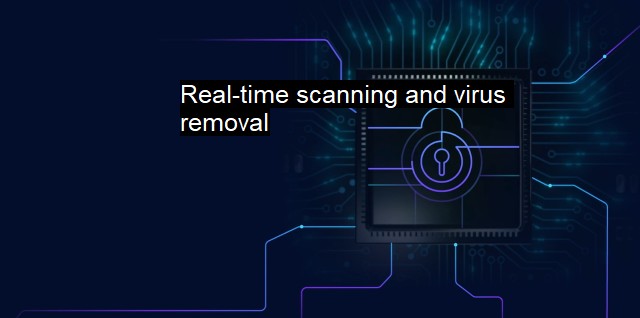What is Real-time scanning and virus removal?
Securing Your Digital Environment: The Importance of Real-Time Scanning and Virus Removal in Cybersecurity
Real-time scanning and virus removal are crucial components in the realm of cybersecurity and antivirus software. They deliver continuous surveillance and effective elimination of malicious threats aimed at infiltrating computer systems, playing a critical part in securing digital assets against an ever-increasing rate of cyberattacks.Real-time scanning or on-access scanning involves constant background checking for potential threats on computer systems. This scanning includes incoming and outgoing emails, downloaded files, and other online encounters. What sets the real-time scanning apart from manual or scheduled scanning is its capacity to monitor activities at any given instant. As soon as a file is opened, the real-time scan evaluates the file’s potential to harm the system. Typically, the antivirus software accomplishes this by comparing the scanned item against its threat database. If it identifies any related match of a known malware or suspicious activities, the software instantaneously halts the action or alerts the user.
Cyber attackers generally do not follow a specific timeline to deploy a threat. Since attacks can be introduced into the system at any moment, real-time scanning becomes invaluable. It ensures that computer systems are not left exposed and vulnerable while waiting for the next scheduled scan to happen. By prescreening every action on the computer system, any malicious script that could potentially cause damage to hardware, compromise software, or steal sensitive information gets intercepted.
Virus removal, when speaking with is about processes and applications that identify, isolate, and eliminate viruses from computer systems. Since a virus can replicate and spread to other files or systems, it's critical to eradicate it completely, else it could reoccur. Virus removal seeks to end this cycle by using unique identifiers, called signatures, found within antivirus software databases to pinpoint the virus’s presence in a system.
The malware removal process's first step usually involves an antivirus software, with a regularly updated signature database, scanning the entire system. This comprehensive scan help detects the presence of any harmful entities. Once identified, the software prompts the user about the list of threats and takes appropriate action based on the default software settings.
This process then continues to the elimination phase, where the antivirus software attempts to remove the virus by deleting the infected files or tries quarantining them by moving the infected file to a designed 'safe place’. This ensures that the tainted file is isolated from the rest of the computer system and can no longer pose a threat.
Certain particularly tenacious viruses are designed to evade detection or return after a seemingly successful removal. This is where heuristics-based detection comes in, making it possible to identify new, unknown viruses or variations of previously identified malware. It uses characteristics usually found in malicious activities while tracking such behaviors to proactively mitigate any threats that have bypassed the initial virus scan.
To summarize, real-time scanning and virus removal form the foundation and pinnacle of cybersecurity and antivirus approaches. Real-time scanning influences proactive protection on the frontline, detecting incoming threats before they infiltrate systems and begin to propagate. Concurrently, virus removal provides a posteriori protection by expelling succesfully infiltrated threats and preventing them from propagating and wreaking havoc. Real-time scanning's continuous vigilance coupled with the robust virus removal contributes immensely towards maintaining the integrity of computer systems and data security amidst an ever-evolving cyber landscape.

Real-time scanning and virus removal FAQs
What is real-time scanning and virus removal?
Real-time scanning and virus removal is a cybersecurity feature that continuously monitors your device for any malicious activity and instantly removes any detected viruses or malware. This feature actively protects your computer or mobile device from cyber threats in real-time.How does real-time scanning and virus removal work?
Real-time scanning and virus removal works by constantly scanning your device's files and processes for any suspicious activity or malicious code. Once a virus or malware is detected, the software immediately removes it from your device before it can cause any harm. This helps keep your device and personal information safe from cyber attacks.Why is real-time scanning and virus removal important?
Real-time scanning and virus removal is important because it provides active protection against cyber threats. Cybercriminals are constantly developing new ways to breach computer systems and steal sensitive information, so having a reliable antivirus program that can detect and remove viruses in real-time is crucial for maintaining the security of your device and data.Can I rely on real-time scanning and virus removal alone to protect my device?
While real-time scanning and virus removal is a powerful tool in protecting your device, it is important to understand that it should not be relied on as the sole means of cybersecurity. It is always best to practice safe browsing habits, use strong and unique passwords, and keep your software and operating system up-to-date to further enhance your device's security.| | A | | | B | | | C | | | D | | | E | | | F | | | G | | | H | | | I | | | J | | | K | | | L | | | M | |
| | N | | | O | | | P | | | Q | | | R | | | S | | | T | | | U | | | V | | | W | | | X | | | Y | | | Z | |
| | 1 | | | 2 | | | 3 | | | 4 | | | 7 | | | 8 | | |||||||